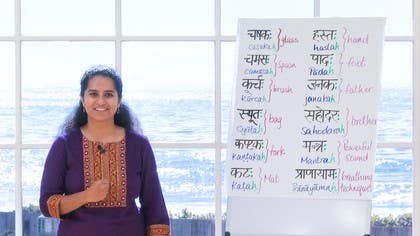Description
About This Video
Transcript
Read Full Transcript
Namaste dear Sanskrit lovers, very happy to be back with you again and I am really excited about this next important step that we are going to take together. Thus far we have looked at the sounds which are the fundamental building blocks of any language. We then moved into the letters, the script which represents the sounds. So we are making something more subtle into more concrete with a visual representation of the subtle sound vibration. Then we went into combining these sounds together.
So now we are putting the bricks together to build the palace of language. Following that we next have to look at the words. So how words are formed. In Sanskrit what is crucial is to be able to identify the gender of the word. Once we know the gender of the word everything else is easy.
So we have three genders. You have the masculine gender, the feminine and the neuter. Now it is not as simple as you think because you imagine that the gender of a word would have to do with the sex or the gender of the object itself. It works most of the time but not necessarily always. We have the word daraaha for wife but which is a masculine plural word.
And then we have another one kalatram for wife again but it is a neuter word. So paying attention to the word ending is what is going to give us a clue about the gender of that word. I will give you an example. So words that have an ending of aha tend to be masculine. Words that have an ending of a or e tend to be feminine.
And words that have a neutral ending tend to have an am at the end. That is a very simple way of trying to identify at first glance the gender of a word. And in Sanskrit the masculine is known as pulinga. The feminine is sthree-linga, sthree meaning lady, linga is the gender. And then you have the napun-sakalinga, napun-sakalinga.
So these are the three genders that we have. But what is again important in Sanskrit and I think it is important in life in general is to know how to get back to the root. So we will talk about that more as we play along with this aspect of the language. Understanding the root is very helpful in knowing how to build the word when it combines with other words in a sentence. So let us go for it.
We will explore each of the genders independently and I will give you some tips along the way. So come along. Let us have fun.







You need to be a subscriber to post a comment.
Please Log In or Create an Account to start your free trial.